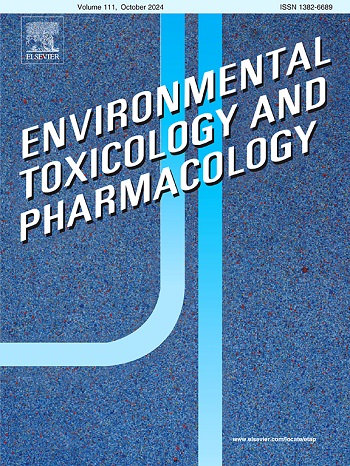Are glyphosate or glyphosate-based herbicides linked to metabolic dysfunction-associated steatotic liver disease (MASLD)? The weight of current evidence
IF 4.2
3区 环境科学与生态学
Q2 ENVIRONMENTAL SCIENCES
引用次数: 0
Abstract
Metabolic dysfunction-associated steatotic liver disease (MASLD) affects around 30 % of the world’s population, increasing its prevalence by 50 % in the last three decades. MASLD pathogenesis is considered multiaxial, involving disturbances in the liver, adipose tissue (AT), and gut microbiome. In parallel with MASLD increasing trends, the total herbicide use has nearly tripled over the last three decades. Glyphosate (GLY) is the most used herbicide worldwide (825 mi kg/year). The intensive use of GLY-based herbicides (GBH) – largely driven by the adoption of glyphosate-tolerant genetically modified crops over the past two decades - has led to environmental (soil and water) and food contamination, resulting in continuous human exposure. Emerging (pre)clinical data highlights the significant implications of this herbicide on MASLD, marking a critical research area. Thus, this narrative review paper aimed at gathering and evaluating all epidemiological and (pre)clinical data on the implications of GLY or GBH on MASLD outcomes. Our work encompassed literature published between 2008–2025. Human urinary GLY levels are associated with different MASLD outcomes (steatosis risk, advanced fibrosis, increased transaminases) and comorbidities (higher risk for metabolic syndrome, diabetes, obesity and cardiovascular diseases) (6 studies). In vitro data indicate that GBH/GLY cause oxidative stress, genomic instability, apoptosis, and membrane disruption in hepatocytes, while promoting apoptosis and lipid peroxidation in (pre)adipocytes and cytokine production in monocytes (15 studies). In rodent studies (21 studies), GLY/GBH - in doses based on human exposure/toxicological limits - induces inflammatory and oxidative responses in the liver and AT, while causing dysbiosis and metabolic alterations in the gut microbiome axis. In the light of populational-, cell- and animal-based evidence, GLY/GBH disturbs key axis of MASLD pathogenesis and is hypothesized to be associated with its clinical outcomes.
草甘膦或草甘膦除草剂与代谢功能障碍相关的脂肪变性肝病(MASLD)有关吗?当前证据的重要性
代谢功能障碍相关的脂肪变性肝病(MASLD)影响约30% %的世界人口,在过去三十年中其患病率增加了50% %。MASLD的发病机制被认为是多轴的,涉及肝脏、脂肪组织(AT)和肠道微生物群的紊乱。与MASLD增加的趋势同时,除草剂的总使用量在过去三十年中几乎增加了两倍。草甘膦(GLY)是世界上使用最多的除草剂(825 mi kg/年)。在过去的二十年中,由于采用了耐草甘膦的转基因作物,大量使用gly基除草剂(GBH)导致了环境(土壤和水)和食品污染,导致人类持续接触。新出现的(前)临床数据突出了该除草剂对MASLD的重要影响,标志着一个关键的研究领域。因此,这篇叙述性综述论文旨在收集和评估GLY或GBH对MASLD结局影响的所有流行病学和(前)临床数据。我们的研究涵盖了2008-2025年间发表的文献。人尿GLY水平与不同的MASLD结局(脂肪变性风险、晚期纤维化、转氨酶升高)和合并症(代谢综合征、糖尿病、肥胖和心血管疾病的高风险)相关(6项研究)。体外数据表明,GBH/GLY可引起肝细胞氧化应激、基因组不稳定、细胞凋亡和膜破坏,同时促进(预)脂肪细胞的凋亡和脂质过氧化以及单核细胞的细胞因子产生(15项研究)。在啮齿类动物研究中(21项研究),GLY/GBH -剂量基于人类暴露/毒理学极限-诱导肝脏和AT的炎症和氧化反应,同时引起肠道微生物群轴的生态失调和代谢改变。根据基于人群、细胞和动物的证据,GLY/GBH扰乱了MASLD发病机制的关键轴,并被假设与其临床结果相关。
本文章由计算机程序翻译,如有差异,请以英文原文为准。
求助全文
约1分钟内获得全文
求助全文
来源期刊
CiteScore
7.00
自引率
4.70%
发文量
185
审稿时长
34 days
期刊介绍:
Environmental Toxicology and Pharmacology publishes the results of studies concerning toxic and pharmacological effects of (human and veterinary) drugs and of environmental contaminants in animals and man.
Areas of special interest are: molecular mechanisms of toxicity, biotransformation and toxicokinetics (including toxicokinetic modelling), molecular, biochemical and physiological mechanisms explaining differences in sensitivity between species and individuals, the characterisation of pathophysiological models and mechanisms involved in the development of effects and the identification of biological markers that can be used to study exposure and effects in man and animals.
In addition to full length papers, short communications, full-length reviews and mini-reviews, Environmental Toxicology and Pharmacology will publish in depth assessments of special problem areas. The latter publications may exceed the length of a full length paper three to fourfold. A basic requirement is that the assessments are made under the auspices of international groups of leading experts in the fields concerned. The information examined may either consist of data that were already published, or of new data that were obtained within the framework of collaborative research programmes. Provision is also made for the acceptance of minireviews on (classes of) compounds, toxicities or mechanisms, debating recent advances in rapidly developing fields that fall within the scope of the journal.

 求助内容:
求助内容: 应助结果提醒方式:
应助结果提醒方式:


